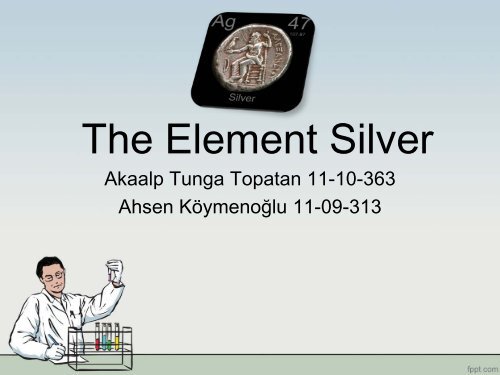The Element Silver
Create successful ePaper yourself
Turn your PDF publications into a flip-book with our unique Google optimized e-Paper software.
<strong>The</strong> <strong>Element</strong> <strong>Silver</strong><br />
Akaalp Tunga Topatan 11-10-363<br />
Ahsen Köymenoğlu 11-09-313
<strong>The</strong> Chemical symbol of <strong>Silver</strong><br />
Ag<br />
• Each chemical element is<br />
given a unique chemical<br />
symbol<br />
• <strong>The</strong> chemical symbol for<br />
silver is Ag<br />
• <strong>The</strong> same symbol for <strong>Silver</strong><br />
is used all over the world
<strong>The</strong> meaning of the name <strong>Silver</strong><br />
• <strong>The</strong> world silver originates<br />
from the old English Anglo-<br />
Saxon word ’’seolfor ’’<br />
meaning silver<br />
• It is symbol ‘Ag’ is derived<br />
from the latin world<br />
‘’Argentum’’ meaning<br />
silver.
<strong>The</strong> Atomic Number of <strong>Silver</strong><br />
• All of the Chemical<br />
elements are given a<br />
unique Atomic Number<br />
47<br />
• Atoms are made up of<br />
three kinds of smaller<br />
particles,called<br />
protons,neutrons and<br />
electrons
<strong>The</strong> Atomic Number of <strong>Silver</strong><br />
• <strong>The</strong> atomic number is<br />
the number of protons<br />
in atom<br />
• <strong>The</strong> elements of the<br />
periodic table are<br />
shown in order of their<br />
atomic number and<br />
identified by their<br />
symbol<br />
47
Discovery of <strong>Silver</strong><br />
• <strong>Silver</strong> was discovered<br />
around 400 BC<br />
• <strong>Silver</strong> was used by some<br />
of the oldest civilisations<br />
• <strong>Silver</strong> is one of the ‘Metal<br />
of Antiquity’
• <strong>Silver</strong> is one of the over<br />
100 different known<br />
elements<br />
• Each element is first<br />
identified at room<br />
temperature and pressure<br />
as being a solid,liquid or<br />
gas.<br />
• <strong>Silver</strong> is a SOLİD in<br />
normal room temperature<br />
and pressure.
Characteristic and Properties<br />
• Physical<br />
properties can be<br />
observed and<br />
measured.<br />
• Chemical<br />
properties<br />
how an element<br />
reacts with other<br />
substances
What is a <strong>Silver</strong> ?<br />
• <strong>Silver</strong> is a solid<br />
• <strong>Silver</strong> is a<br />
lustrous,silvery-white<br />
metallic element<br />
• One of the scarlest<br />
elements
• Most silver used today is<br />
obtained from its<br />
ores,including argentite<br />
• <strong>The</strong> leading producers are<br />
Mexico,USA,Russia,Australia<br />
and Canada
Physical Properties of <strong>Silver</strong><br />
• Physical properties of <strong>Silver</strong> can usually be<br />
observed using our senses or involve a<br />
numerical measurement<br />
• Color : White<br />
• Luster : Lustrous shine<br />
• Ductility : It can be beaten into thin sheets<br />
• Malleability : Capable of being shaped<br />
• Conductivity : Excellent electrical and heat<br />
conductor<br />
• Solubility : Has the ability to be dissolved<br />
• Hardness : A relatively soft metal<br />
• Density : It is a dense metal
Chemical Properties of <strong>Silver</strong><br />
• Chemical properties are the characteristics that<br />
determine how a substance will react with other<br />
substances when it is changed chemically<br />
• Reactivity : <strong>Silver</strong> does not react with water<br />
or air<br />
• Oxidation : Oxygen absorption increases<br />
with temperature and pressure<br />
• It is quickly tarnished<br />
• Compounds :<strong>Silver</strong> forms complex<br />
compounds, most of which are soluble in<br />
water<br />
• <strong>The</strong> extraction from ores requires<br />
cyanidation
<strong>Silver</strong> – Transition Metals<br />
• <strong>Element</strong>s that have common<br />
properties and characteristics<br />
are placed into groups<br />
• <strong>Silver</strong> is in the group called<br />
Transtion Metals
Common properties of Transition Metals<br />
• Few colors, most silver-gray<br />
• Melleable and Ductile<br />
• Conduct heat or electricity<br />
• Hard and dense<br />
• Less reactive than Alkali metals<br />
• Iron,copper,silver and gold are important<br />
transition metals<br />
38<br />
ELEMENTS
What are the uses of silver ?<br />
• <strong>Silver</strong> is an indicator of wealth and<br />
used in:<br />
• Currency<br />
• Coinage<br />
• Jewelry<br />
• Tableware<br />
• Dental alloys
References<br />
• http://www.rsc.org/periodic-table/element/47/silver<br />
• http://www.elementalmatter.info/element-silver.htm<br />
• http://www.ducksters.com/science/chemistry/silver.p<br />
hp<br />
• http://www.minerals.net/gemstone/silver_gemstone.a<br />
spx


